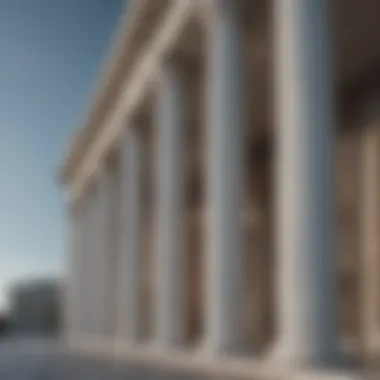The Architectural Significance of Fluted Doric Columns


Intro
Research Overview
Summary of Key Findings
Research into fluted Doric columns reveals several key insights:
- They reflect mathematical precision and balance in their design, showcasing an understanding of proportions.
- Their fluted surfaces enhance both strength and visual appeal, serving both structural and decorative functions.
- The utility of these columns in modern architecture demonstrates their continuing relevance.
Background and Context
The Doric order is one of the classical architectural styles originating in Ancient Greece around 600 BC. Characterized by its simplicity and sturdiness, the Doric column features a fluted design that enhances its visual and structural integrity. The fluting, typically consisting of 20 concave grooves, lends a sense of rhythm and movement to the column's surface.
Fluted Doric columns were predominant in structures like the Parthenon in Athens, emphasizing the harmony and beauty that architectures from this era achieved. As architectural styles evolved, so too did the adoption and adaptation of these columns in various movements, particularly during the Renaissance and Neoclassical periods.
Methodology
Experimental Design
The examination of fluted Doric columns combines historical analysis with architectural critique. Various edifices are studied to understand how fluted columns were utilized, including their proportions, materials, and contextual significance.
Data Collection Techniques
Data was collected through:
- Literature reviews of historical texts on ancient Greek architecture.
- Structural analysis of existing columns from monuments and buildings that showcase the Doric order.
- Case studies on the influence of Doric columns in modern architectural designs.
This multi-faceted approach offers a rounded perspective on the evolution and significance of fluted Doric columns in the architectural landscape.
"Fluted Doric columns signify a blend of utility and beauty, essential in understanding the evolution of architectural styles."
The rising influence of these columns continues to resonate strongly in architectural theory today, making them a focal point in the study of architectural artistry.
Foreword to Fluted Doric Columns
Fluted Doric columns represent a crucial aspect of classical architecture, acting as both structural supports and aesthetic features. In this article, we explore their deep-rooted significance, focusing on their defining characteristics and historical context. Understanding fluted Doric columns enriches appreciation for their role in architectural heritage, highlighting their enduring influence on design principles.
Definition and Characteristics
Fluted Doric columns are characterized by their vertical grooves, known as flutes, which run along the shaft of the column. These flutes create a distinct shadow effect that enhances the perception of height and elegance. Traditionally, Doric columns are the simplest among the classical orders, defined by their sturdy, unadorned base and capital. They are widely regarded for their proportions, usually standing around eight times the width of their diameter.
The fluted design serves both aesthetic and practical purposes. It reduces the visual bulk of the column, making large structures seem more graceful. Additionally, the grooves aid in the drainage of rainwater, a crucial consideration in Ancient Greek architecture.
Historical Overview
The history of fluted Doric columns can be traced back to Ancient Greece, where they were first employed in temples and public buildings. The Doric order emerged around the 7th century BCE, evolving from earlier wooden columns into their stone counterparts. The Parthenon, built in the fifth century BCE, serves as a chief example of Doric architecture, displaying the perfection of fluted design.
As time progressed, the Doric style transitioned into Roman architecture, where it was adapted and refined. Roman architects embraced the column's structural integrity while introducing variations that expanded its aesthetic potential. This interplay between Greek and Roman design principles ultimately shaped Western architectural tradition, establishing Doric columns as timeless symbols of strength and simplicity.
The Evolution of Doric Columns
The evolution of Doric columns is a critical aspect in understanding the broader narrative of classical architecture. As these columns transitioned from their original forms in ancient Greece into the more elaborate adaptations found in Roman architecture, they embodied not just aesthetic changes, but also shifts in cultural values and technological advancements. Grasping this evolution provides insight into how architectural practices evolve over time and adapt to new historical contexts.
Origins in Ancient Greece
The Doric column has its roots firmly planted in the architectural practices of ancient Greece, appearing around the 7th century BCE. Distinct for their simplicity and sturdiness, these columns were characterized by a fluted shaft that rose smoothly without a base. The design reflects the Greeks' emphasis on austerity and proportion. The flutes, typically 20 per column, not only serve a visual function but also aid in load-bearing; their design effectively helps to distribute weight. The canonical examples of Doric columns can be found in the Temple of Hera at Olympia and the Parthenon in Athens.
The sturdy and direct approach of the Doric style symbolized strength and masculinity, fitting for temples dedicated to male deities such as Zeus. The Greeks did not see columns merely as functional supports; instead, they viewed them as vital elements of their architectural lexicon—bringing together aesthetics and engineering.


Transition to Roman Architecture
As Greek culture diffused through conquests and trade, the Roman Empire adopted and adapted the Doric column. However, they introduced their unique modifications that reflected their era's indulgences and demands. Roman architects preserved the fundamental structure but infused it with ornamentation and proportions that leant towards grandeur. In particular, the Romans developed the Tuscan order, a simpler variation of the Doric column, but they also achieved a fusion with more ornate styles, such as the Composite order.
Roman advancements in materials and engineering allowed for more substantial and increasingly decorative columns. Use of concrete enabled larger and more complex edifices, leading to iconic structures such as the Pantheon, where Doric elements were merged with other classical styles. The transition illustrates a cultural shift wherein columns were no longer just functional pieces but critical to expressing imperial power and sophistication.
"The evolution from Greek to Roman columns marks a dialogue between tradition and innovation, highlighting shifting priorities in architectural and cultural identity."
In summary, the narrative of Doric columns is not just a study of physical forms but represents an exchange of ideas across centuries. The move from the utilitarian simplicity found in ancient Greece to the elaborate interpretations within Roman architecture reveals the columns' significance beyond mere structural components.
Structural Integrity of Fluted Doric Columns
The structural integrity of fluted Doric columns is a foundational aspect of their architectural significance. The design of these columns goes beyond mere aesthetics; it serves crucial engineering functions as well. Fluted columns have been integral to countless structures, playing a vital role in the distribution of loads. The unique design also brings uniqueness in terms of materials used and their strength, impacting the longevity of the buildings they support.
Role in Load Distribution
Fluted Doric columns, often recognized for their vertical grooves, contribute significantly to the way weight is transferred from the roof to the foundation. The fluting not only serves an aesthetic purpose but also enhances the load-bearing capacity of the columns. Their cylindrical form, combined with the fluted design, allows for better distribution of forces acting on them.
When properly spaced and proportioned, these columns can support massive structures, such as temples and public buildings. The design enables a more uniform load distribution, reducing stress concentrations at specific points. This results in increased stability.
"The structural design of fluted Doric columns reflects a remarkable understanding of engineering principles in ancient times."
Material Considerations and Strength
Material selection plays a crucial role in the effectiveness of fluted Doric columns. Traditionally, columns were crafted from materials such as marble or limestone. These materials are not only robust but also capable of withstanding the compressive forces experienced by columns in large structures.
Considerations about materials also involve evaluating their behavior under various conditions. For example, natural stone is susceptible to weathering, while modern materials like reinforced concrete can enhance the strength and durability of column structures. Incorporating materials with resilient properties can reduce maintenance needs over time.
In summary, fluted Doric columns represent a confluence of art and functionality in architecture. Understanding their structural integrity leads to a deeper appreciation of their role not only as decorative elements but as functional components in the longevity of monumental buildings.
Aesthetic Qualities of Fluted Surfaces
The aesthetic qualities of fluted surfaces in Doric columns play a critical role in the overall architectural narrative. Architecture is not only about functionality but also visual appeal. The fluting on Doric columns is both an artistic expression and a way to enhance structural elements. This section will detail the beauty and significance of these aesthetic traits.
Design Elements and Proportions
Fluted Doric columns employ specific design elements that enhance their elegance. The fluting consists of vertical grooves that run down the column’s shaft. These grooves create a rhythm that guides the viewer’s eye upward, drawing attention to the capital. Traditionally, Doric columns have 20 flutes. This consistent number adds to their appeal. The proportions of the column, typically characterized by a sturdy, tapered design, also ensure a pleasing balance.
In ancient times, architects considered the proportions of a column essential. The height-to-diameter ratio is carefully calculated. For Doric columns, a common ratio is about 4:1. This proportion gives them an imposing stature.
Visual Impact on Architecture
The visual impact of fluted Doric columns is profound. These columns contribute to the character of classical structures. They embody strength and simplicity, serving as a reminder of ancient architectural principles. Fluted surfaces provide texture, creating shadows that change with the light throughout the day. This dynamic effect adds interest in an often-static medium like stone.
Furthermore, these columns create a dialogue with the surrounding elements. Their vertical lines enhance the height of buildings, contributing to a more significant presence in urban environments.
"The fluted surfaces of Doric columns express a blend of strength and grace, serving both form and function in architectural design."
In summary, the aesthetic qualities of fluted surfaces are essential in architecture. They define style, structure, and cultural significance. As we appreciate these features, we see how they touch on deeper themes of beauty in function.
Cultural Significance of Fluted Doric Columns
Fluted Doric columns hold deep architectural and cultural significance that goes beyond their structural role. These columns are a powerful symbol of Ancient Greek ideals, reflecting both artistic expression and socio-political values of their time. The meticulous design and functionality of these columns encapsulate a rich narrative about the culture from which they originate, making them a crucial study for students and professionals alike.
Symbolism in Ancient Greek Society
In Ancient Greece, columns were not merely architectural elements, but rather symbols that conveyed values and beliefs. The Doric order, characterized by its simplicity and strength, represented the ideals of masculinity and virtue. The fluted design added a sense of rhythm and elegance, symbolizing the balance between form and function.
This architectural choice resonated with the Greek appreciation for symmetry and order. The columns were often found in temples dedicated to gods, serving both as a physical support and as a spiritual symbol of worship and reverence.
Key aspects include:


- Strength and Stability: Reflecting the robustness of Greek civilization.
- Order and Beauty: Demonstrating the Greeks’ pursuit of harmony in design.
- Civic Pride: Many public buildings featured these columns, reinforcing community identity.
"The Doric column was not just a support; it was the embodiment of Greek ideals, reflecting the marriage of strength and beauty."
Influence on Renaissance Architecture
The fluted Doric column had a profound impact on Renaissance architecture, marking a revival of classical ideals. Designers and architects of the Renaissance admired Ancient Greek culture, and they embraced the elegance of fluted Doric columns, integrating them into civic buildings, churches, and palaces.
During this period, the emphasis on humanism also contributed to an appreciation for classical architecture. Previous architectural styles were revisited and interpreted through a new lens, incorporating Doric columns as visual allies in conveying authority and beauty in design.
Significant influences include:
- Adoption of Classical Forms: The use of Doric columns in famous structures like St. Peter’s Basilica.
- Integration in Civic Projects: Columns became staples of government buildings as symbols of democracy and order.
- Blend of Art and Science: Architects utilized mathematical precision in fluting to enhance aesthetic appeal while maintaining structural integrity.
In summary, fluted Doric columns are not just structural elements. They are rich symbols rooted in Ancient Greek values, echoing through architecture from the classical era into the Renaissance. Their cultural significance lies in their ability to convey strength, beauty, and civic pride, making them enduring icons in the landscape of architectural history.
Technical Aspects of Fluted Column Design
Fluted Doric columns exemplify the culmination of aesthetics and engineering in classical architecture. Understanding their technical aspects is essential to grasp their architectural significance. This section will explore the mathematical principles involved in their design and the engineering challenges encountered during their construction.
Mathematical Principles in Column Fluting
The fluting of Doric columns is not only a design choice but also one deeply rooted in mathematics. The flutes, typically measuring around one-third of the column's diameter, create an illusion of height. This effect has its basis in geometric principles.
Key mathematical concepts include:
- Proportion: The ratio of the flute depth to the total height of the column determines its visual harmony.
- Symmetry: Each flute must be evenly spaced, ensuring that the entire column maintains balance.
- Curvature: The shape of the flutes is often a segment of a circle, consistent with the overall circular profile of the column.
These mathematical principles affect how light interacts with the column surfaces, enhancing its aesthetic appeal. They create shadows and highlights that contribute to the dramatic effect of these structures in architectural settings.
Engineering Challenges and Solutions
The integration of fluted designs into Doric columns also presents several engineering challenges. Constructing these columns requires precise measurements and skilled craftsmanship. Common issues faced include:
- Material Constraints: Selecting the right materials is crucial. Soft stones may require more meticulous carving to achieve the fluted effect without damaging the integrity of the column.
- Structural Stability: Fluting reduces the material of the column, thus potentially affecting its load-bearing capacity. Engineers have to consider the distribution of weight and stress across fluted surfaces.
- Construction Techniques: Creating flutes must harmonize with traditional techniques, such as the use of lathe machines or hand chisels, while ensuring consistent depth and spacing.
Solutions have evolved over time. Using stronger materials, like granite or reinforced concrete, allows for safe implementation of fluted designs. Additionally, modern technology enables better precision in measurements, resulting in aesthetically pleasing and structurally sound columns.
"The design of a fluted column is not merely for beauty; it reflects a deep understanding of engineering principles that have stood the test of time."
Fluted Doric Columns in Modern Architecture
Fluted Doric columns continue to resonate in modern architectural contexts. Their classical lines and robust forms make them influential in various building designs today. As cities evolve and architectural styles shift, these columns are often reinterpreted. Their significance stems from a combination of aesthetic appeal, structural integrity, and cultural heritage.
Modern architects draw inspiration from ancient designs to create contemporary structures that honor traditional aesthetics while incorporating modern techniques. The integration of fluted Doric columns into today's buildings goes beyond mere imitation. It reflects a respect for history and an understanding of architectural elements that convey strength and beauty.
Contemporary Interpretations
Fluted Doric columns in contemporary architecture often take new forms. Architects appreciate their stately presence and ability to anchor designs in historical context. Many modern interpretations adapt the classic fluted design in materials such as glass, steel, and reinforced concrete, offering innovative visual language and flexibility. For instance, some structures use fluted patterns that blend seamlessly with modern aesthetics.
Furthermore, the height and proportion of these columns can vary based on project demands. By modifying scale and material, designers create a connection to the past while addressing current architectural needs. This balances beauty and function effectively.
- Materials: New materials enable greater design freedom, allowing fluted Doric columns to appear lighter and more ethereal than their stone predecessors.
- Styles: Contemporary adaptations sometimes incorporate minimalist styles. This reflects a blend of traditional and modern design philosophies.
Case Studies of Modern Use
Several case studies exemplify the successful integration of fluted Doric columns in modern architecture. Notable examples include:
- The National Gallery of Art in Washington, D.C.: This building features classic fluted columns prominently. Their presence grounds the modern structure within the classical canon.
- The Lincoln Center for the Performing Arts in New York City: The use of fluted forms within the venue's design underscores a commitment to tradition in a bustling urban context.
- The Kimbell Art Museum in Fort Worth, Texas: Although modern, the building employs fluted columns that pay homage to their classical roots, creating an elegant and inviting entrance.
These examples prove the adaptability and relevance of fluted Doric columns today. They speak to a broader narrative of architectural evolution where tradition and innovation meet. As such, the features of hexagonal flutes, proportions, and techniques become even more valuable in discussions of architectural design.


Environmental Considerations in Column Construction
Environmental considerations play a critical role in the construction of fluted Doric columns. As societies become more aware of sustainability and environmental impact, it is essential to address the materials and methods used in column design and construction. This section delves into the approaches that can minimize ecological footprints while maintaining architectural integrity.
Sustainable Material Choices
The selection of sustainable materials in column construction is vital. Traditional materials like stone or concrete may have a significant carbon footprint due to extraction, processing, and transportation. However, there are alternatives that can be considered:
- Recycled Materials: Using crushed recycled concrete or repurposed stone can reduce waste and lower emissions related to new materials.
- Locally-Sourced Materials: Sourcing materials locally lessens transportation emissions and supports local economies.
- Timber: For certain applications, responsibly sourced timber can offer a sustainable option. Wood has a lower environmental impact and can be carbon-neutral if sourced from well-managed forests.
These choices contribute not only to the sustainability of fluted Doric columns but also to the aesthetics of the structure, reflecting a harmonious relationship with the environment.
Impact of Climate on Durability
Climate plays a significant role in determining the durability and longevity of fluted Doric columns. Different environmental factors can affect the materials used:
- Moisture: High humidity can cause deterioration in some materials, leading to a need for treatments or protective coatings.
- Temperature Extremes: Regions with significant temperature fluctuations may require columns that can withstand thermal expansion and contraction without cracking.
- Air Quality: Polluted urban environments can negatively impact the integrity of materials, particularly stone. Selecting materials that are resistant to such elements ensures better longevity.
Overall, understanding the interplay between climate and materials assists in making informed decisions.
"Incorporating environmental principles not only benefits the planet, but it also enhances the resilience of architectural elements."
By considering both sustainable material choices and climatic impacts, architects can create fluted Doric columns that are not only visually appealing but also environmentally responsible.
Fluted Doric Columns and Urban Development
Fluted Doric columns play an essential role in the context of urban development. Their distinctive design serves as a bridge between the classical ideals of ancient architecture and the needs of modern cityscapes. Understanding how these columns integrate into civic architecture provides deeper insights into their significance. The presence of fluted Doric columns ensures that public buildings not only fulfill functional requirements but also convey a sense of history and cultural continuity.
Role in Civic Buildings
Civic buildings often represent the heart of urban life, including town halls, libraries, and government offices. Fluted Doric columns contribute significantly to the aesthetic and symbolic value of these structures. They evoke a sense of dignity and permanence, qualities that are vital for institutions that govern and serve communities. The fluting enhances the visual appeal by creating light and shadow, which adds depth to the appearance of the columns and the buildings they support.
In addition to their aesthetic contribution, these columns offer structural benefits. Their robust design not only supports the upper loads of buildings but also enhances stability. This dual functionality is particularly crucial in urban environments where buildings must withstand various stresses, from frequent seismic activity to the weight of modern constructions.
• Historical Significance: The use of Doric columns in civic architecture links modern structures to ancient Greek ideals, establishing a connection to democracy and civic duty.
• Visual Cohesion: Fluted Doric columns can be strategically used to create continuity in urban aesthetics, making public spaces more cohesive.
"The elegance of fluted Doric columns is not just in their appearance but also in their capacity to inspire trust and respect in public places."
Integrating Columns in Urban Design
The integration of fluted Doric columns within urban design presents opportunities for enhancing public spaces. These columns can be key components in developing plazas and parks, providing shaded areas and acting as focal points for gatherings. When architects consider the placement of Doric columns, they often think about how these structures can encourage social interaction while showcasing classical design.
Moreover, the adaptation of Doric columns in urban development is not merely about imitation of ancient styles. Contemporary designs can incorporate modern materials and techniques while retaining the essence of fluted columns. This synthesis results in innovative applications that respect traditional aesthetics while addressing modern functional requirements.
• Flexibility: Fluted Doric columns can be used in various contexts, such as residential buildings, commercial spaces, and public parks, blending seamlessly into diverse urban backdrops.
• Cultural Symbolism: As urban centers evolve, these columns serve as reminders of the philosophical and cultural ideals from which they originate, reinforcing the narrative of communal identity.
By understanding and employing fluted Doric columns in urban settings, designers can create spaces that are both emblematically rich and architecturally engaging. The careful balance and integration of these columns within modern urban design projects contribute significantly to the overall character of cities.
Closure
The exploration of fluted Doric columns reveals their profound significance in architecture. They are not merely decorative elements; they embody a synthesis of functionality and aesthetics that has captivated architects across centuries. Fluted Doric columns serve critical structural roles, ensuring stability while also enhancing the visual appeal of buildings. Their elegance provides a window into the values and artistry of Ancient Greece, influencing various architectural styles that followed.
Recap of Key Points
In summarizing the key points, it's evident that:
- Historical Relevance: Fluted Doric columns emerged from Ancient Greece, becoming symbols of strength and beauty in architectural design.
- Structural Integrity: They offer excellent load distribution, crucial for the durability of significant structures.
- Aesthetic Appeal: The fluting creates a play of light and shadow, enriching the overall visual experience.
- Cultural Impact: These columns have influenced various movements, including the Renaissance, reflecting their enduring legacy in architectural language.
Future of Fluted Doric Columns in Architecture
Looking ahead, the future of fluted Doric columns appears promising. There is a growing trend towards using classical elements in contemporary designs. Architects are integrating these columns into modern buildings, not just as an homage to the past but as a functional design choice. For instance, many civic buildings and public spaces incorporate fluted columns to convey a sense of grandeur and permanence.
In addition, advancements in materials and engineering are making it easier to implement fluted designs in innovative ways. Sustainability concerns are also driving the use of traditional architectural elements, as architects seek to create structures that honor historical forms while utilizing modern, eco-friendly materials. This amalgamation of old and new signifies a vibrant future for fluted Doric columns, keeping their legacy alive in the evolving landscape of architecture.







